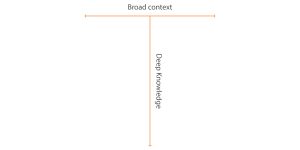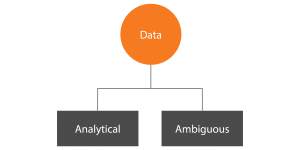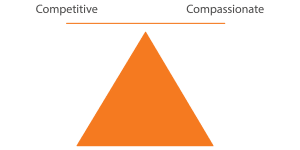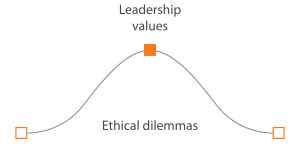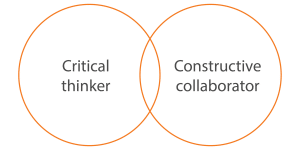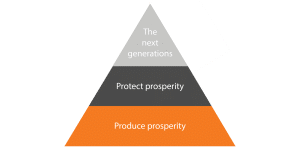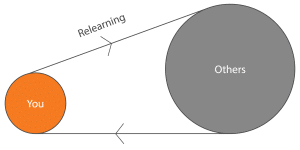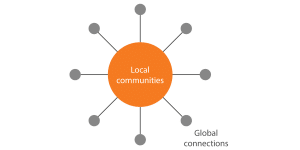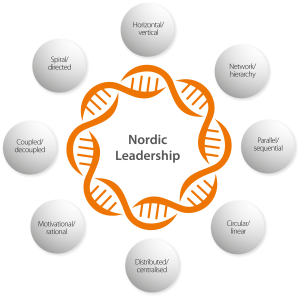One point of view does not show the whole picture
In today’s globalized and complex world, leadership has become a critical and challenging issue. Leaders need to engage with multiple perspectives, dimensions, and dilemmas to navigate through the uncertainties, complexities, and paradoxes of the contemporary business environment. This essay will explore engagement in a Nordic leadership perspective. It will also examine the dimensions of a new Nordic Leadership Model (NLM) and the two challenging dilemmas at its centre.
One of the core ideas is that one point of view does not show the whole picture – you need a multidimensional understanding of people and situations to choose, act and respond eloquently.
Just to give you an idea of how limiting your perception of the whole picture can be, imagine that you see a circle. If you fail to examine it further, you may miss that it could be a spiral or cylinder seen from above or below, just like a triangle could really be a pyramid. Or have you ever tried looking at aerial photographs or satellite images? It can be hard to decide exactly what different structures are because you only get a two-dimensional view from an unusual angle.
Our brain is quick to try to arrange new information into already fixed boxes and patterns and this makes us less eager to question our own first impressions and assumptions. In most situations this is fine. The autopilot of our brain is capable and helps us navigate everyday life with a minimum of brain activity. But sometimes autopilot is not enough. Sometimes you need to realize that a situation calls for a more thorough examination or analysis and that your assumptions could be wrong or at least insufficient.
For a great illustration of how a limited perspective can rob you of a fuller understanding, try to have a look at this gif:
Introduction
Leadership is evolving from a traditional, hierarchical model to a more complex and multifaceted one. Similarly, the values that we associate with the good leader are changing. It is becoming less about authority in the formal sense, less about control and more about authenticity and engaging people. A number of different theories and schools of leadership are adding to this – from the ideas of the servant leader to the concept of psychological safety and nurturing a growth mindset, empowering people to make strong decisions. A leader needs to be able to understand people to inspire and motivate them. This demands emotional intelligence as well as strong communication skills and values that are perceived as worthy of striving for.
The more traditional two-dimensional approach – the leader decides, the employees obey – does not suffice to bring about the best results. Engaged, empowered and accountable people are much more likely to act expediently and on their own accord. Leadership, then, becomes less about issuing orders and more about having an engaging vision and a clear strategy that is understood by everyone involved. And it is crucial that the leader understands how to engage people and how to turn that engagement into meaningful actions that will help the organization achieve the goals it sets.
The new Nordic Leadership Model offers a unique approach to engagement that combines various dimensions and perspectives, not least fundamental values. This essay aims to explore the new Nordic Leadership Model’s dimensions and how leaders can apply them to engage effectively.
The Nordic Nine
The Nordic Nine is a set of nine transformational leadership and organizational capabilities, developed by the Copenhagen Business School, where the author is an external Associate Professor. It explores the nine values that are fundamental to Nordic leadership, reflecting the values of the Nordic societies.
Every choice we make defines the future. How do we share the resources? How green do we need our world to be? How should we treat our fellow citizens? What should we pass on to future generations? Our daily lives pose difficult questions that we need to address, and we need to reflect further on what we used to take for granted/issues demanding action. This new reality is reflected in the business community and society where employees and leaders are expected to co-create new ethical, social, and sustainable solutions. The ability for reflection lives in all of us. With Nordic Nine, we train this ability together to reflect on how each of us can contribute to a positive future.
It should be noted that though these values characterize the different Nordic societies at large, there are differences between and within the countries, and the values will sometimes be more like an ideal than the absolute reality. But all the Nordic countries share an egalitarian culture with emphasis on collaboration combined with a strong appreciation of individual rights and contributions. And they have been a driving force behind the success of Nordic organizations and societies.
These values include:
- Equality – treating everyone with fairness and respect, regardless of their background, gender, or ethnicity. Nordic leaders believe that diversity is a strength and embrace inclusiveness in all aspects of the organization. Diversity strengthens decision making and innovation.
- Trust – is about building relationships based on mutual respect and openness. Nordic leaders believe that trust is essential for creating a culture of engagement, where everyone feels heard and valued and no one is afraid to suggest improvements or even radical changes.
- Collaboration – is about working together towards a common goal. Nordic leaders believe that collaboration is essential for creating a culture of innovation, where everyone feels free to share their ideas and opinions.
- Innovation – is about finding new and better ways of doing things. Nordic leaders believe that innovation is essential for staying competitive and adapting to changing market conditions.
- Sustainability – is about taking responsibility for the environment and society. Nordic leaders believe that sustainability is a fundamental and should be implicit in all strategy, all business models, and all value chains.
- Pragmatism – is about being able to adapt to circumstances, handle unexpected events and grab unexpected opportunities instead of insisting on sticking to a goal that may no longer be the right one.
- Simplicity – is about removing organizational clutter, empowering people to get things done without having to consult with a number of managers or bureaucratic procedures.
- Openness and transparency – are fundamental for building trust. In a psychologically safe environment, it is possible to acknowledge mistakes and learn from them. Values and priorities should be clear as should chains of responsibility.
- Responsibility and accountability – are also fundamentals for trust and for building a work environment where people can count on each other and on their leaders.
Specifically, the Nordic Nine consists of the following transformational capabilities, according to which we teach the new generation of Nordic leaders. After all, teaching is the leadership of learning:
No. 1 – You have deep business knowledge placed in a broad context
No. 2 – You are analytical with data and curious about ambiguity
No. 3 – You recognise humanity’s challenges and have the entrepreneurial knowledge to help resolve them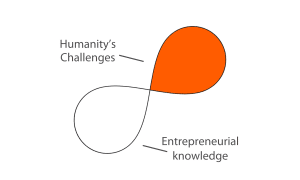
No. 4 – You are competitive in business and compassionate in society
No. 5 – You understand ethical dilemmas and have the leadership values to overcome them
No. 6 – You are critical when thinking and constructive when collaborating
No. 7 – You produce prosperity and protect the prosperity for the next generation
No. 8 – You grow by relearning and by teaching others to do the same
No. 9 – You create value from global connections to local communities
The Nordic Nine highlight the importance of engagement from multiple perspectives, emphasizing the value of diversity and inclusiveness. By embracing these values, leaders can foster a culture of engagement, where everyone feels heard and valued.
This goes hand in hand with Tim Urban’s recent definition of leadership: “Leadership is the ability to move things in a direction that the cultural forces are not already taking things.”
My work with the Nordic Nine has sparked the creation of the new Nordic Leadership Model, which I’ve developed through a synthesis of my experience as a marketeer, a leading executive search consultant, a top executive coach and my academic work at Copenhagen Business School and as an associate at Møller Institute, Churchill College, the University of Cambridge. It offers a unique approach to engagement that combines various dimensions and perspectives, not least fundamental values. Let’s explore how leaders can apply the model to engage more effectively in the workplace.
The new Nordic Leadership Model (NLM)
Over the years, I’ve refined my new Nordic Leadership Model, synthesising many of the dynamics I’ve previously mentioned. In some ways it’s my capstone model.
A useful illustration to help visualise the new Nordic Leadership Model is the DNA helix. In its inherent beauty, DNA symbolises life itself, while in this context it represents an organisation in its form as a breathing organism – eg centralising and decentralising over time, being dynamic instead of static.
This model is all about finding the sweet spot in specific situations without compromising your fundamental values as a leader or risking the future of the organisation. My work has resulted in identifying the following eight dimensions:
1. Horizontal/vertical
Definition: This refers to the structure of an organisation. Horizontal structures are characterised by a flat hierarchy, where decision making is decentralised and employees have a large degree of autonomy. Vertical structures are designed to work top-down; decision making is centralised and employees have less autonomy.
Required action: Depending on organisational needs and the specific job at hand, leaders need to find the right balance between horizontal and vertical. The vertical dimension should be limited to what’s necessary in order to ensure a clear strategy and alignment across the organisation.
Desired outcome: Leaders will operate more effectively by providing employees with the necessary autonomy and clear boundaries within which to make independent decisions, while still maintaining control over the organisation. A hybrid culture will allow for flexibility, agility and collaboration while also ensuring accountability and efficiency.
2. Network/hierarchy
Definition: This dimension refers to the way in which information flows within an organisation and how decisions are made. In a networked organisation, information flows freely between employees and decisions are made collaboratively. In a hierarchical organisation, information flows top-down and decisions are made solely by senior management.
Required action: Depending on the situation, leaders need to engage with both network and hierarchy to create an equilibrium between bottom-up engagement and top-down governance.
Desired outcome: Information flows freely and everyone’s opinion is heard. Leaders will empower local decision making where appropriate, while key strategic decisions remain the responsibility of senior management and the board.
3. Parallel/sequential
Definition: This refers to the way in which tasks are completed. In a parallel system, tasks are completed simultaneously by different teams or individuals. In a sequential system, tasks are completed one after another, in a specific order.
Required action: Depending on the organisation’s needs, leaders need to consider both parallel and sequential systems. Some tasks are better suited to a traditional sequential system with a high level of control and security, while others can benefit from an agile or beta approach in which different teams or individuals can experiment their way towards a solution. Leaders must weigh up which approach will be the most relevant to the job at hand.
Desired outcome: Leaders will ensure that tasks are completed efficiently and results are achieved while still allowing for collaboration, creativity, experimentation and innovation.
4. Circular/linear
Definition: This refers to the way in which communication and decision making works within an organisation. In a circular system, there’s no set hierarchy and communication flows freely between employees. In a linear system, there’s a set hierarchy and communication flows from the top down.
Required action: Leaders need to engage with both dimensions to create a culture that allows for continuous learning, adaptation and transformation while also ensuring stability, predictability and control.
Desired outcome: A culture that incorporates a more circular approach – one that opens up alternatives, is more flexible and invites input, while also allowing a more directive, linear approach, according to the task at hand.
5. Distributed/centralised
Definition: This refers to the way in which decision making is handled within an organisation. In a distributed system, decision making is decentralised and employees have more autonomy. In a centralised system, senior management makes all the decisions.
Required action: Leaders need to find a way of balancing these dimensions by providing employees with the necessary autonomy to make decisions while still maintaining control over the organisation. In times of crisis, power needs to go peripheral. Think of the way in which the Covid-19 pandemic necessitated local decision making and how it was handled in different regions. When business becomes more ‘as usual’, centralisation tends to reappear.
Desired outcome: A culture that allows for diversity, local context and empowerment while ensuring coherence, consistency and alignment.
6. Motivational/rational
Definition: This refers to the way in which employees are motivated and engaged and to what degree decisions should be based on data and facts or values and ideals.
Required action: Leaders need to acknowledge that even rationality depends on basic values. If the purpose of a given organisation is to maximise profit (which is a motivational idea), it becomes rational to use cheap labour. However, if the values are based on sustainability, using cheap labour would be completely irrational. Leaders need to ensure that decisions are based on both emotions and data, and for the right reasons. Values and ideals aren’t necessarily irrational but contrary to purely rational decisions they hinge less on data and more on what feels like the right thing to do.
Desired outcome: A culture that balances intuition and analysis – one that allows for purpose, meaning and passion while honouring logic, evidence and facts. Leaders will be transparent about what motivates them to make particular decisions.
7. Coupled/decoupled
Definition: This refers to the way in which tasks and goals are connected within an organisation. In a coupled system, they’re interconnected and the success of one task or goal depends on the success of another. In a decoupled system, the success of one task or goal doesn’t depend on the success of another.
Required action: Leaders need to engage with both dimensions by ensuring that tasks and goals are interconnected and the people within the organisation can count on others while still allowing for individual flexibility and adaptability.
Desired outcome: A culture that balances interdependence and independence – one that allows for collaboration, empathy, accountability and social responsibility while encouraging autonomy, self-reliance, integrity, authority and differentiation.
8. Spiral/directed
Definition: The directed dimension is about getting from A to B in a planned and predictable manner. It’s ideal for existing practices where nothing fundamental needs to change and decisions about optimisation usually come from the top. The spiral dimension allows for continuous improvement and learning, with people collaborating and sharing knowledge along the way. Often the spiral dimension has a longer time perspective.
Required action: Leaders need to ensure that, where appropriate, teams can make their own decisions. Think in terms of the directed dimension being similar to single loop learning (making adjustments to correct mistakes or problems) and the spiral dimension being similar to double and triple loop learning (understanding what caused the problem and taking action to correct it, then going deeper to understand why decisions are made and the purpose and values that underpin them).
Desired outcome: A culture that’s built for continuous improvement and learning, while giving leaders leeway to apply the directed dimension where necessary. Think evolution rather than revolution.
Even if you can’t immediately see them all, the eight dimensions are all present in the DNA helix. If you flatten it out and make it two-dimensional, you can easily see the horizontal/vertical and spiral/directed dimensions. Imagine the other dimensions connecting into them like the ‘rungs of the ladder’ (base pairs) on a helix. The traditional organisational diagram represents flatland; it is two-dimensional and static. The new Nordic Leadership Model is spherical and dynamic. Bear in mind that, when you look at an organisational chart, it’s only one side of the coin. If you follow the new Nordic Leadership Model, you’re less likely to follow the path of least resistance (the hierarchical path). Your perception of reality is dependent on your filters. If you accept an organisational chart with a formal structure, you also accept all the limitations inherent within it. The more organic, integrated structure of this new model will therefore influence your behaviour, your beliefs and your ideas, so that you’ll be able to use your creativity when seeking solutions. The aim is always to find a balance between the two matching dimensions. My hope is that the Nordic Leadership Model will create a paradigm shift in the way you look at how organisations are run – in practice, not in theory. After all, we’re all inherently flawed human beings.
I want to leave you with this image of the DNA helix. This image will help you notice – and react – when you instinctively opt for a well-known perception that fits into your existing paradigm. Please challenge yourself and look out for convictions that no longer serve you well. Not only will it make you a more interesting conversation partner, it will also help you to experience some of the clarity and relaxed readiness that I’ve previously mentioned.




